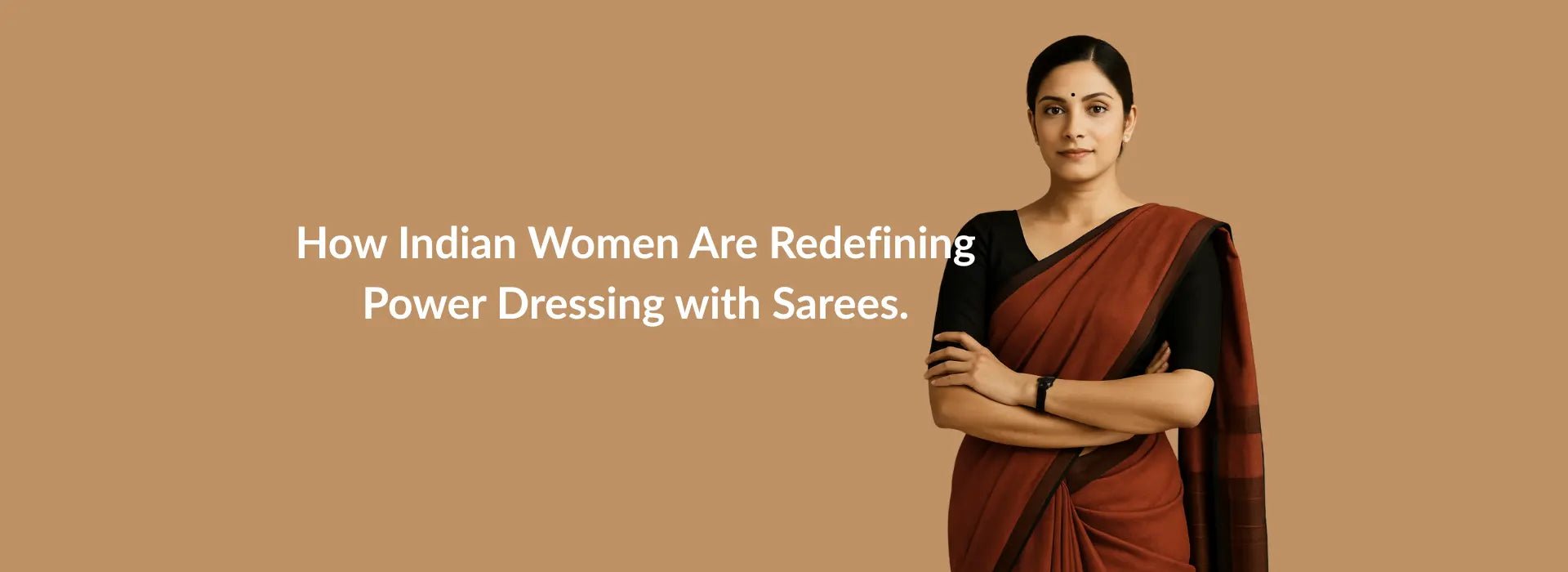Table of Contents
Power dressing is no longer limited to pantsuits and blazers. Across India—from corporate offices in Mumbai to creative studios in Bengaluru and courtrooms in Delhi—women are turning to sarees as their statement of strength, identity, and cultural pride. Whether it's a crisp handloom cotton or a fluid silk, sarees are being reimagined as the modern woman's armor.
1. Saree in the Workplace: Redefining Formal Wear
Gone are the days when sarees were reserved for traditional events. Today, women are confidently wearing breathable, well-draped cotton sarees in boardrooms. Lightweight fabrics like mulmul and linen are preferred for daily wear, offering both comfort and class. Paired with structured blouses or jackets, sarees give an edge to corporate dressing.
2. Public Figures Setting Saree Trends
From politicians like Smriti Irani and Mahua Moitra to entrepreneurs like Falguni Nayar and Sudha Murty, powerful Indian women continue to wear sarees proudly. Their choices often reflect heritage weaves, regional styles, and a commitment to Indian craftsmanship.
3. Sarees and Personal Branding
Sarees help women stand out. Whether it's an artist in Goa donning hand-painted Kalamkari or a professor in Kolkata flaunting crisp Dhakai cotton, the saree adds personality. For many, it's more than fashion—it's a statement of values and authenticity.
4. Comfort Meets Class: The Cotton Saree Revolution

Cotton sarees are leading this shift, especially in urban India. Women in cities like Hyderabad, Chennai, and Pune are embracing softer weaves like mulmul, chanderi, and khadi cotton. They're breathable, elegant, and effortless for long working hours.
5. Styling Sarees for a Power Look
-
Choose bold, solid colors or minimal handwoven patterns.
-
Opt for elbow-length, closed-neck blouses for a formal edge.
-
Add belts or jackets for a fusion silhouette.
-
Pair with statement accessories, but keep it minimal.
6. Why Sarees Matter in 2025 and Beyond
As the world leans into sustainable fashion, sarees offer a conscious wardrobe choice. They're timeless, versatile, and reusable across years and occasions. For the Indian woman, power dressing now comes with six yards of history and pride.
Conclusion
Indian women aren't just wearing sarees; they're rewriting what it means to be powerful, feminine, and professional. Whether it's in a courtroom or a creative agency, sarees are asserting that power dressing is deeply personal—and uniquely Indian.
Frequently Asked Questions
1. Can sarees be worn as power dressing?
Yes! Indian women wear sarees in workspaces and formal settings to express authority, confidence, and cultural pride with grace and elegance.
2. Which saree fabrics are best for daily office wear?
Cotton, mulmul, linen, and khadi are ideal for office wear. They are breathable, lightweight, and comfortable for long working hours, making them perfect for everyday power dressing.
3. How do I style a saree to look more professional?
Pair your saree with a high-neck or collared blouse, opt for solid colors or subtle prints, and keep accessories minimal. You can also add a waist belt or blazer to give it a contemporary, power-packed touch.
4. Are sarees trending as power dressing choices in India?
Yes, in 2025, more Indian women are embracing sarees as symbols of confidence, culture, and professionalism—whether in corporate spaces, creative industries, or politics.
5. What kind of sarees does Indidha offer for power dressing?
Indidha offers a curated collection of pure cotton sarees like mulmul, khadi, and handwoven styles that blend comfort with class—perfect for modern women redefining power dressing.




